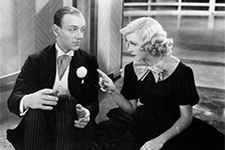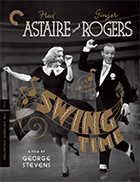Swing Time
|  The sixth of the eventual ten film collaborations between Fred Astaire and Ginger Rogers, Swing Time is one of their greatest films. The plot is, as in all of the Astaire-Rogers vehicles, a bit flimsy, but just sturdy enough to support the film’s raison d’être—its musical numbers, which feature what is arguably the best set of songs in any of their films (an admittedly bold statement given that their other films feature songs by Irving Berlin, George Gershwin, and Cole Porter, among others), as well as the most sublime choreography. Over their previous five films, Astaire and Rogers had developed a chemistry that needed only the slightest tweaking in each rendition, with a few variations on the dependable formula of animosity-turned-romance enacted through song and dance. In this iteration, Astaire stars as John “Lucky” Garnett, a small-time hoofer and gambler who is all set to marry when his wedding is derailed and he is forced to go to New York City (with literally nothing in his pocket) to earn $25,000 to prove his worth to his fiancée’s stern father (Landers Stevens, father of director George Stevens). Along for the ride is Pop Cardetti (Victor Moore), an amiable old-time grifter and card shark who is Lucky’s best friend and best accomplice. Once in New York, Lucky meets Penny Carroll (Ginger Rogers), a dance instructor with whom he simultaneously falls in love and annoys mightily by unknowingly engaging in a con in which Pop steals a quarter from her. To get into her good graces, Lucky pretends to not know how to dance so he can get a free session with Penny, which offers us a rare glimpse of Astaire slipping and tripping over his own feet while trying to execute a simple dance step. He soon proves what an amazing dancer he is, though, and he and Penny are paired as high entertainment in a ritzy art-deco nightclub, which goes all over Ricky Romero (Georges Metaxa), the club’s orchestra conductor who carries a torch for Penny and therefore refuses to play whenever she is on the dance floor with Lucky. There are all manner of additional complications, including the aforementioned fiancée (Helen Broderick) to whom Lucky tries to stay true even though we know he is falling for Penny and she for him (of course, to keep things extra confusing, he is reluctant to tell her he is engaged, so all of his aloofness comes off like he just doesn’t like her). The plot is sometimes contrived, sometimes clever, and frequently lurches from development to development with only the thinnest threads of logic, but it doesn’t really matter because it supports some of the best musical numbers in the Astaire-Rogers oeuvre, including the beautiful, Oscar-winning ballad “The Way You Look Tonight” (which ends on a great visual gag without undermining the romance of it all), the jaunty “Pick Yourself Up” (which President Obama quoted in his Inaugural Address), and the amusingly satirical “A Fine Romance.” The score was composed by Jerome Kern, who at the time was best known for scoring the 1927 Broadway musical Show Boat, while the lyrics were penned by Dorothy Fields, who had already worked on several Broadway shows and nearly 20 films (the 1935 Astaire-Rogers film Roberta had been adapted from Kern’s 1933 Broadway musical, for which Fields had supplied additional lyrics to those originally written by Otto Harbach). And then, of course, there’s the dancing, and Swing Time features some of the most transcendent, memorable choreography in all of Astaire and Rogers’ films. There are three major duets in the film, each of which represents a different stage of Lucky and Penny’s relationship, beginning with the initial courtship and ending with separation. Astaire and Rogers are always glorious to watch in concert, but they seem particularly synched in Swing Time, partially because of their ability to build on their previous work together. They had just had a major hit the previous year with Top Hat (1935), and while Swing Time was followed by a steady decline in popularity in their films, it remains a pinnacle of music and choreography, which mixes tap, ballet, jazz, and waltzes in ways previously unimaginable. Unfortunately, the film is marred by one of its most famous dance sequences, Astaire’s solo performance to “Bojangles of Harlem,” the only time he ever appeared in blackface. While the number is ostensibly an homage to the great Bill “Bojangles” Robinson, a great performer who broke numerous color barriers during his lifetime (including his many screen collaborations with Shirley Temple), it actually hijacks Robinson’s name in service of highlighting Astaire’s very different dance style. There is much to admire about the sequence in terms of music and movement; however, seeing Astaire partake in the racist tradition of imitating African Americans and therefore evoking all the pain and misery of slavery and then minimizing its painful fallout (this was the Jim Crow era, after all), will forever sully what is otherwise a genuinely splendid, effervescent musical romantic comedy for the ages.
Copyright © 2019 James Kendrick Thoughts? E-mail James Kendrick All images copyright © The Criterion Collection | |||||||||||||||||||||||||||||||
Overall Rating: 


 (3.5)
(3.5)


